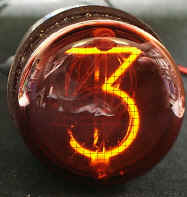
A Note About Nixie Tubes
Nixie tubes were developed in a variety of sizes and orientations; they continued to be manufactured by Russia into the 1980s. Some of the Russian tubes, like the IN-18, are quite nice. Other Russian tubes cheat a bit by using the same filament cut for the 5 and 2.



Examples of side-view and end-view Nixies, and a Pixie tube.
A different variation on the Nixie tube is the Pixie tube, which can be thought of as a single tube with a circle of neon elements inside. Each element is located behind a number mask, and the elements are lit up to display numbers as desired.
When originally introduced, Nixie tubes were too expensive for simple clocks, and were only used for lab equipment such as voltmeters and frequency displays. However, with the advent of LED and LCD displays, which have much more "benign" driver requirements, Nixie tubes fell by the wayside, and became the object of desire for retro electronic hobbyists. A number of microprocessor-driven clock circuits are available on the web (and Ebay), and the goal here is to highlight the beauty of these displays with interesting enclosures.
About the clocks
A number of hobbyists have produced circuits for driving Nixie clocks. I could certainly do no better, so I use their circuits. Single-tube clocks (7.1 and 7.2) use a circuit from Pete's Kits. The only options are to switch between 12- and 24-hour time, and control how the digits fade. Clocks with six tubes typically offer more options; I have tried drivers from several sources, and have settled on the TubeHobby driver. The TubeHobby driver has the most useful features, and interesting display changeovers. Plus, the designer is in Lithuania, and I am of Polish-Lithuanian descent, so I feel a bit of kinship to him. The TubeHobby driver automatically adjusts for Daylight Savings Time, can display the date for a portion of each minute, can be programmed to turn off for a designated period to preserve tube life, and has battery backup for time and settings retention.
To see the full features of each type of clock, please download the instructions below. NOTE: If you purchase a clock with a different driver (the prototypes of clocks 8 and 10), you will receive instructions specific to that clock.
| Single-Tube Instructions | Six-Tube Instructions |